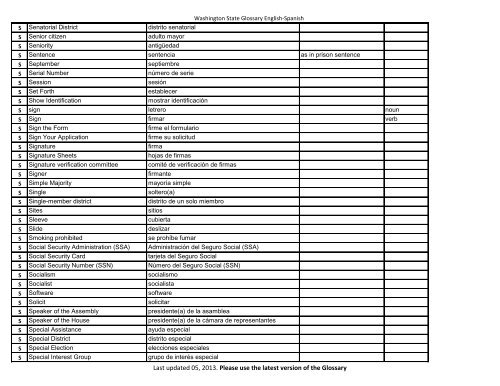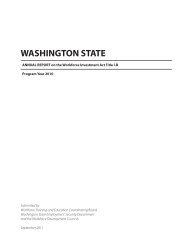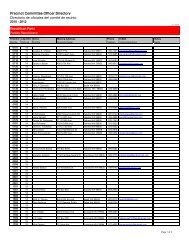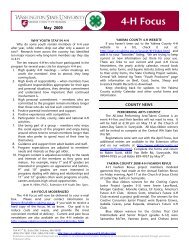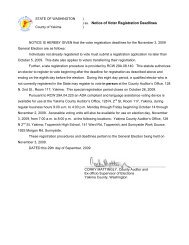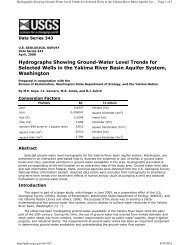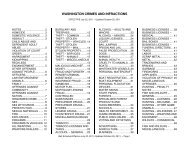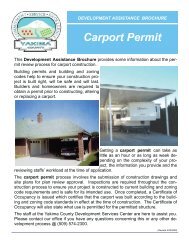Washington State Elections Glossary English ... - Yakima County
Washington State Elections Glossary English ... - Yakima County
Washington State Elections Glossary English ... - Yakima County
You also want an ePaper? Increase the reach of your titles
YUMPU automatically turns print PDFs into web optimized ePapers that Google loves.
UKRAINE-RUSSIA COOPERATION IN THE NUCLEAR POWER ENGINEERING SECTORIn particular, thanks to those joint efforts, allprocedures were successfully accomplished requiredto get a licence to extension of service life of powerunits 1-2 at the Rivne NPP for 20 years, issued by the<strong>State</strong> Nuclear Regulatory Committee on December 10,2010. 16Prospects of nuclear power generation. The EnergyStrategy of Ukraine provided for NPP installed powergrowth from 13.835 GW to 29.5 GW. In particular, it isplanned to accomplish construction and commissionbefore the end of 2016 power units 3 and 4 at theKhmelnytskyj NPP. 17 In pursuance of those plans, a tenderfor the reactor unit choice was held in 2008. The RussianAtomstroyexport CJSC won the tender, having proposedimproved VVER-1000 (V-392B) reactor units, to be builtby Izhorskiye Zavody OJSC.Already at that stage, many questions arose as tothe power unit completion project. Since the time ofthe tender, there has been no project feasibility studyand, respectively, reasonable pricing parameters, so itremains unknown on the basis of what calculations talksare being held about Russian credits for constructionfunding by the Ukrainian side. 18 Estimates of theconstruction cost mentioned in official statements (someUAH 30 billion, or $4-5 billion), were questionedby many experts as overstated. 19 Doubts were alsoexpressed about the utility of power units’ completionusing old building structures and their fitting with VVERreactors. 20But despite the doubts and reservations, theGovernments of Ukraine and the Russian Federation onJune 9, 2010, signed the Agreement of cooperation inconstruction of power units 3 and 4 at Khmelnytskyj NPP.Noteworthy, the Agreement carries an unusual for theworld practice obligation of the customer – Ukraine –to feed the new power units only with Russian-madenuclear fuel over their entire service life.The Russian party is to finance 85% of theconstruction value, Ukraine – 15%. A $1 billion creditfor Ukraine to meet its financial commitments under theAgreement will probably be provided by Sberbank RossiiOJSC. Power unit 3 is to be commissioned in 2016, 4 –in 2017.Concerning new NPP construction, the Ministryof Fuel and Energy jointly with Energoatom NNEGCplan to finish compilation of the Cadastre of sites forconstruction of new NPP units in 2011, on whosebasis Energoatom NNEGC will choose the reactortype that may be used in Ukraine (the list of possiblemanufacturers includes Rosatom, AECL (Canada),KEPCO (Korea), АRЕVA (France), Westinghouse andothers).However, as soon as in 2008, the lag behind theterms of preparatory measures and works set by therelevant plans made 1.5-2 years. This questions timelyand full attainment of the objectives set by the EnergyStrategy of Ukraine in this respect.The issue of new power unit construction is ofstrategic importance for Ukraine. Its solution shouldtake into account the following factors: geopoliticaland security priorities of the state; the need todiversify sources of nuclear fuel (and, respectively,choice of reactor types); provision of the requiredparameters of power regulation in electric gridsof the Ukrainian United Energy System throughgreater manoeuvrability of the selected reactor types;employment of the national scientific-technologicalpotential for development and construction of newpower units; Ukraine’s possible accession to theEuropean energy system (UCTE). 21Nuclear fuel cycle (NFC)Ukraine has no complete cycle of nucleartechnologies necessary for production of fresh andprocessing of spent nuclear fuel for NPPs, so it buysfresh fuel from Russia and sends there spent fuel forprocessing and storage – despite the plans of creatinga domestic “partly closed”, or “incomplete” NFCthat did not envisage enrichment of natural uraniumannounced in early 1990s, since employment of therelevant technologies and construction of enterpriseswas deemed unreasonable. With time, this stand hasnot changed, and in October, 2010, Ukraine joinedthe International Uranium Enrichment Centre (IUEC)established on the Russian initiative in Angarsk (seeInsert “International Uranium Enrichment Centre…”,p. 43).16In particular, a Comprehensive inspection performed in November, 2010, established that: the NPP followed conditions of the current licence; data providedin reports of regular reassessment of safety were true; the operator was ready to run power units 1, 2 at the Rivne NPP above the designed term. Reliability ofpower units 1, 2 at the Rivne NPP was also certified by international experts during the IAEA ОSART mission and partner inspections by the World Associationof Nuclear Operators (WANO). See: <strong>State</strong> Nuclear Regulatory Committee issued licence to extend operation of units 1, 2 at Rivne NPP by 20 years. – Officialwebsite of the <strong>State</strong> Nuclear Regulatory Committee, December 16, 2010, www.snrk.gov.ua (in Ukrainian).17The power units’ construction was started in 1987-1988 and suspended because of the moratorium on nuclear facilities’ building in Ukraine after theChornobyl accident. In 2005-2006, expert examination of the structures was held and admitted that the power units could be completed on their basis (physicalreadiness: No.3 – 70%, No.4 – 28%). Energoatom NNEGC is sure that the structures are reliable and can reliably serve for 45 years. See: Russian Federationagreed to credit Ukrainian portion of procurements for Khmelnytskyj NPP completion. – RBC Ukraine, December 12, 2010, http://rbc.ua (in Russian).18As of 2007, the average value of light-water reactor АР-1000 (by Westinghouse) made $2.15 billion, European EPR-1600 reactor (AREVA) – $4 billion,Russian VVER-1000 – $1.67 billion (the Russian Federation agreed to build phase II of the Tianwan NPP in China for $1.7 billion). India in March, 2010, set thereference price of VVER-1000 at $1.6 billion.19See, e.g.: Price of power units for Khmelnytskyj NPP overstated 3-4 times – Sokolovskyj. – Fokus, June 21, 2010, http://focus.ua/politics.20For instance, the <strong>State</strong> Nuclear Regulatory Committee had reservations about the power units’ completion with old structures. See: Ukraine’s <strong>State</strong> NuclearRegulatory Committee considers completion of units 3 and 4 of Khmelnytskyj NPP unsafe. – RBC Ukraine, June 26 2010, http://rbk.ua (in Russian).21Of interest in this respect are the Agreement “On Measures at Provision of Parallel Operation of the United Energy System of the Russian Federation andthe United Energy System of Ukraine” signed on October 27, 2010, and the Prime Ministers’ arrangement of urgent drafting of a long-term agreement that willtie energy systems of Russia and Ukraine. That agreement was unnecessary since the Ukrainian and Russian energy systems are already working in parallel,while having signed the long-term agreement, Ukraine may lose the opportunity of integrating its power grids in the European energy system.RAZUMKOV CENTRE • NATIONAL SECURITY & DEFENCE • No.6, 2010 • 39


